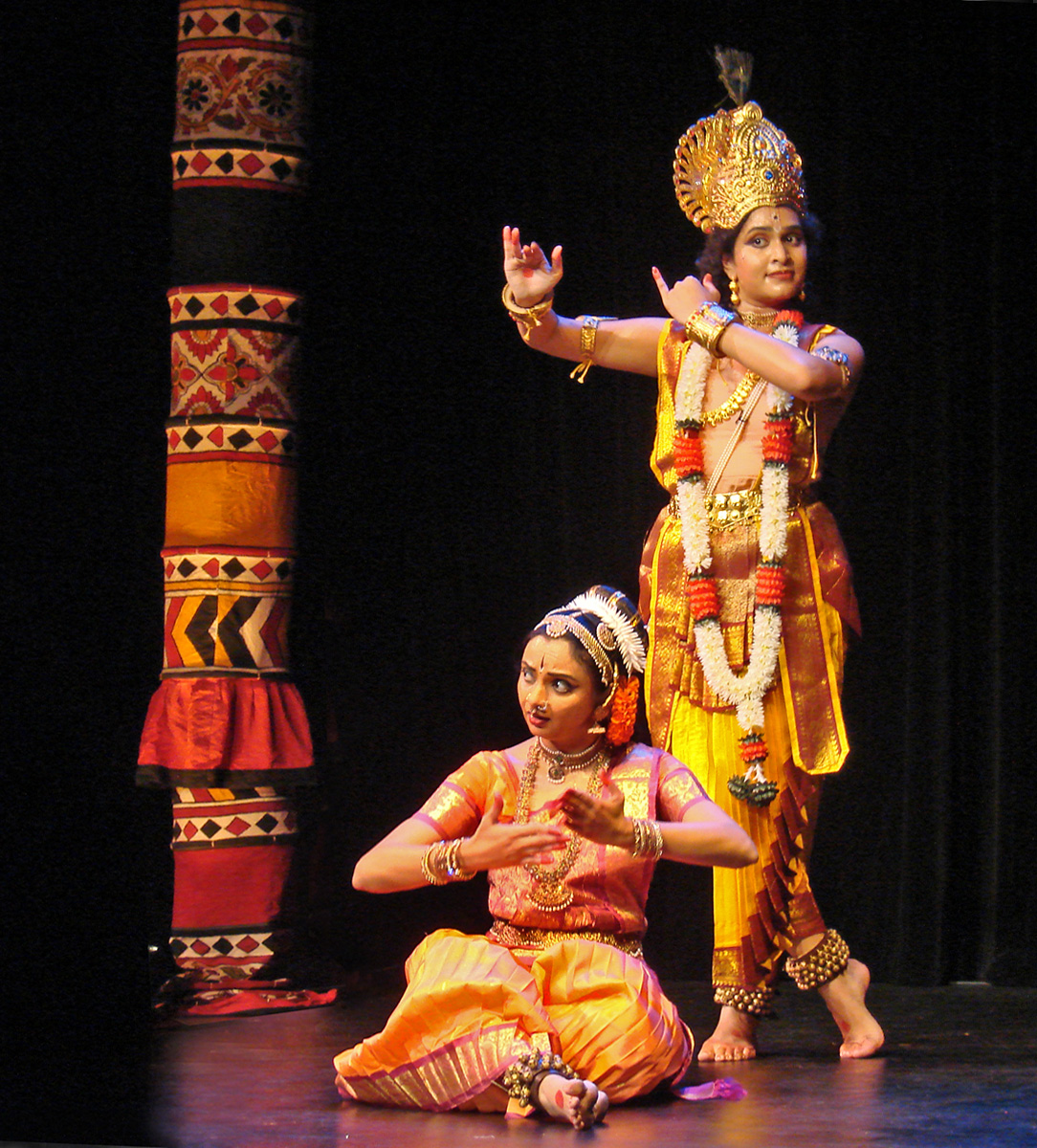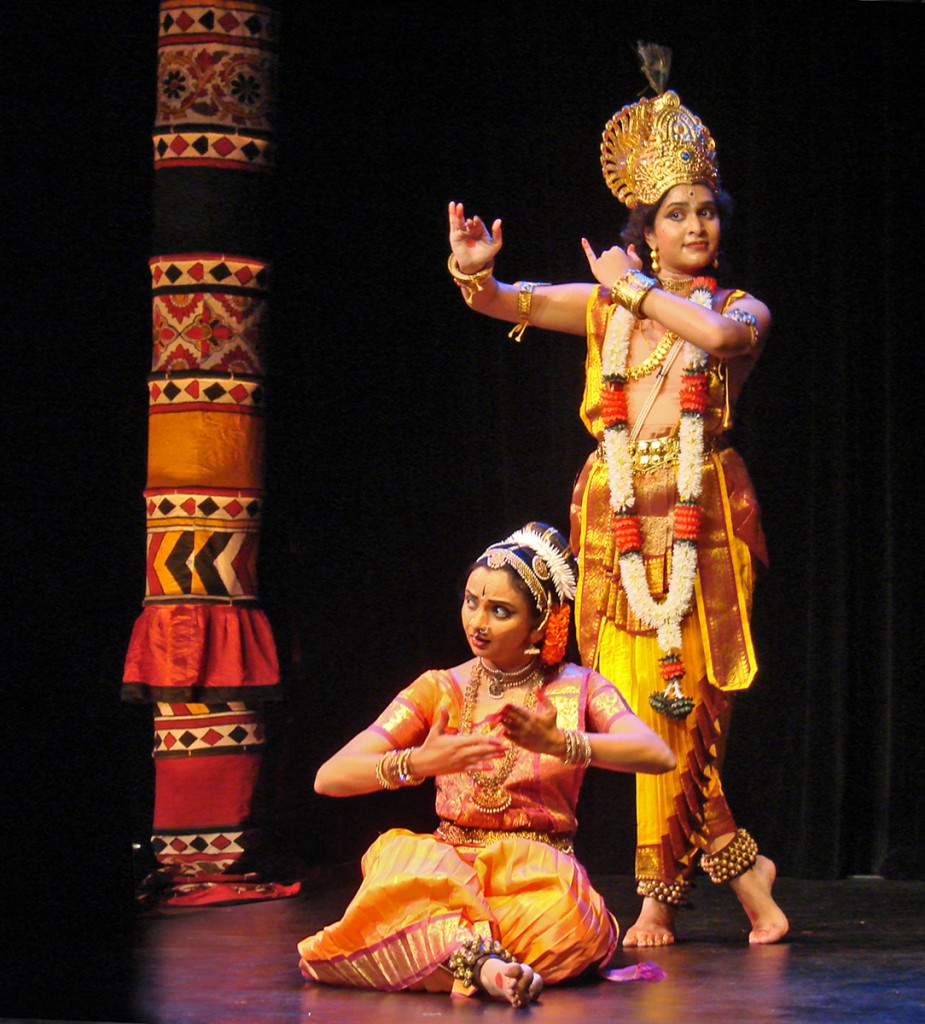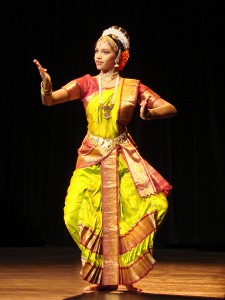
Kuchipudi
Kuchipudi an established dance form originated in Andhra Pradesh. This classical dance is named after a village Kuchelapuram, 65 Kms from Vijaywada in Andhra Pradesh and became popular due to the patronage of the Brahmins practicing it.
Kuchipudi is known for its impressive, quick footwork, dramatic characterization, expressive eye movements and spirited narrative. It is a blend of tandava and lasya elements. A distinctive feature of this dance is the execution on a brass plate and moving the plate to the accompaniment of carnatic music. The Kuchipudi performer apart from being a dancer and actor has to be skilled in Sanskrit and Telugu languages, music and manuscripts of the performance.
It takes at least seven to ten years to master this art form. There were two parallel dance forms Nattuva Mela and Natya Mela. The former developed into Bharathanatyam and Natya Mela into Kuchipudi – usually performed by both women and men in conjunction.
The Kuchipudi is a dance-drama of Nritta, Nritya and Natya. The Nritta consists of Theermanams and Jatis, the Nritya of Sabdams, and the Natya of acting with Mudras (hand gestures) for the songs. Nritta encompasses steps and movements in the form of patterns of dance which, though beautiful, have no meaning to convey. While fast becoming a solo presentation, Kuchipudi still has strong ties to the dance-drama tradition. It combines the elements of speech, mime and pure dance.
Origin and History
The history of Kuchipudi dance can be traced to 1st century B.C. But the popular story was in 1502 A.D. According to local legends, there was an orphan in Srikakulam who was raised by the village and married off in childhood. To acquire knowledge of Vedic studies he went to Udipi and adopted the name Sidhendra Yogi.
After completing his studies he returned to the village where he was advised to take up his familial duties. Traveling to his wife’s village he had to cross a river and started swimming. On reaching a point in the river, he found he couldn’t swim any further. He prayed to God to provide him the strength to swim across and on reaching the river banks vowed to devote his life to religious affairs. He settled in Kuchelapuram and began teaching Brahmin boy’s devotional dance which were later presented as offerings to God and termed Natya Shastra.
The group spearheaded by the Brahmin Bhagavathulu of Kuchipudi in the year 1502 A.D made this classical dance popular, although women were not allowed to participate.
Attire & Style
The Kuchipudi dancers wear light make-up and ornaments like the Rakudi (head ornament), Chandra Vanki (arm band), Adda Bhasa and Kasina Sara (necklace). A long plait is decorated with flowers and jewelry. The ornaments are made of light wood called Boorugu. The costumes are similar to the one worn in Bharatnatyam- The saree is worn with a fan shaped cloth in front and a Pallu (portion of saree hanging over the shoulder) at the back that is stitched. Ghungroos (anklets0 are worn on the feet – these are specially made for creating the sound to the rhythm of the footwork and are an arrangement of bells stitched in a cloth tied to the feet.
Tarangam is a popular style unique to Kuchipudi – source literature being Narayana Teertha’s Sree Krishna Tarangini. This is the form where the dancer places a pot filled with water on her head and feet balanced on the rim of a plate and manipulates the brass plate with gestures without spilling a single drop of water. The Natya –mala is a dance troupe consisting of men who enact the feminine roles.
Present Day Scenario
Kuchipudi is majorly done as a Solo performance by the female dancers. The narrator has been done away with as also the expressional numbers, which were sung by vocalists in the background – now the same is enacted by the dancer herself. The element of devotion to gods has been replaced by a lot of ‘sringar’ or erotic flavour. The drama aspect has been reduced. The main expressional numbers are from: Jaidev’s Ashthapadi, the Ramayana, the Puranas and Tyagaraja’s compositions.
Innovations
Aspects not indigenous to Kuchipudi dance drama such as stances and freezes based on iconographic forms, motifs, shapes have been incorporated into the recitals to make it more competitive with other current dance forms. Apart from mythology, social themes are also subjects of Kuchipudi.
Influences over the years
Vempati Chinna Satyam is one of the leading exponents of Kuchipudi, along with Vedantam Lakshmi Narayana Shastry who have worked hard to restore this art form and bring it back to prominence. Vempati is responsible for setting up Kuchipudi Art Academy in Chennai – the oldest dance school in this dance India.
Other well-known proponents of Kuchipudi are Sobha Naidu (recipient of the Padma Shri civilian award) Raja & Radha Reddy, Swapnasundari (an exceptional dancer and author), Arunima Kumar, Yamini Reddy and Kaushalya Reddy.
Interesting Facts and Comparisons
- Kuchipudi dancers earlier wielded a lot of power, and a play/ social commentary was performed to highlight the unfair treatment of a king in 1502, against abusive practices. The dancers succeeded and even got the help of the army.
- On December 26, 2010, over 2,800 dancers including 200 plus dance teachers, created a Guinness World record at Hyderabad. This amazing event was performed by dancers in over 15 countries and was for 11 minutes.
- This is a unique dance form as it makes use of four Abhinayas namely, Angika, Vachika, Aharya and Satvica respectively.
- Rumya Sree Putcha, a scholar provides an analysis of this traditional dance in Indian cinema, in her doctoral dissertation ‘Revisiting the classical: A critical history of Kuchipudi dance’.
Reference
Categories: Cultural Connections, Indian Performing Arts


